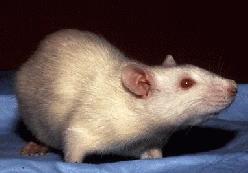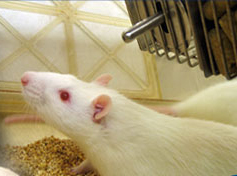Related Research Articles

Inbreeding is the production of offspring from the mating or breeding of individuals or organisms that are closely related genetically. By analogy, the term is used in human reproduction, but more commonly refers to the genetic disorders and other consequences that may arise from expression of deleterious or recessive traits resulting from incestuous sexual relationships and consanguinity.
Inbred strains are individuals of a particular species which are nearly identical to each other in genotype due to long inbreeding. A strain is inbred when it has undergone at least 20 generations of brother x sister or offspring x parent mating, at which point at least 98.6% of the loci in an individual of the strain will be homozygous, and each individual can be treated effectively as clones. Some inbred strains have been bred for over 150 generations, leaving individuals in the population to be isogenic in nature. Inbred strains of animals are frequently used in laboratories for experiments where for the reproducibility of conclusions all the test animals should be as similar as possible. However, for some experiments, genetic diversity in the test population may be desired. Thus outbred strains of most laboratory animals are also available, where an outbred strain is a strain of an organism that is effectively wildtype in nature, where there is as little inbreeding as possible.

ENU, also known as N-ethyl-N-nitrosourea (chemical formula C3H7N3O2), is a highly potent mutagen. For a given gene in mice, ENU can induce 1 new mutation in every 700 loci. It is also toxic at high doses.

The house mouse is a small mammal of the order Rodentia, characteristically having a pointed snout, large rounded ears, and a long and almost hairless tail. It is one of the most abundant species of the genus Mus. Although a wild animal, the house mouse has benefited significantly from associating with human habitation to the point that truly wild populations are significantly less common than the semi-tame populations near human activity.
Heterosis, hybrid vigor, or outbreeding enhancement is the improved or increased function of any biological quality in a hybrid offspring. An offspring is heterotic if its traits are enhanced as a result of mixing the genetic contributions of its parents. These effects can be due to Mendelian or non-Mendelian inheritance.
Backcrossing is a crossing of a hybrid with one of its parents or an individual genetically similar to its parent, to achieve offspring with a genetic identity closer to that of the parent. It is used in horticulture, animal breeding, and production of gene knockout organisms.

The laboratory mouse or lab mouse is a small mammal of the order Rodentia which is bred and used for scientific research or feeders for certain pets. Laboratory mice are usually of the species Mus musculus. They are the most commonly used mammalian research model and are used for research in genetics, psychology, medicine and other scientific disciplines. Mice belong to the Euarchontoglires clade, which includes humans. This close relationship, the associated high homology with humans, their ease of maintenance and handling, and their high reproduction rate, make mice particularly suitable models for human-oriented research. The laboratory mouse genome has been sequenced and many mouse genes have human homologues.
In biology, a strain is a genetic variant, a subtype or a culture within a biological species. Strains are often seen as inherently artificial concepts, characterized by a specific intent for genetic isolation. This is most easily observed in microbiology where strains are derived from a single cell colony and are typically quarantined by the physical constraints of a Petri dish. Strains are also commonly referred to within virology, botany, and with rodents used in experimental studies.

A nude mouse is a laboratory mouse from a strain with a genetic mutation that causes a deteriorated or absent thymus, resulting in an inhibited immune system due to a greatly reduced number of T cells. The phenotype of the mouse is a lack of body hair, which gives it the "nude" nickname. The nude mouse is valuable to research because it can receive many different types of tissue and tumor grafts, as it mounts no rejection response. These xenografts are commonly used in research to test new methods of imaging and treating tumors. The genetic basis of the nude mouse mutation is a disruption of the FOXN1 gene.

A laboratory rat or lab rat is a brown rat of the subspecies Rattus norvegicus domestica which is bred and kept for scientific research. While less commonly used for research than mice, rats have served as an important animal model for research in psychology and biomedical science.

C57BL/6, often referred to as "C57 black 6", "C57" or "black 6", is a common inbred strain of laboratory mouse.
In genetics, two organisms that differ in only one locus and a linked segment of chromosome are defined as congenic. Similarly, organisms that are coisogenic differ in one locus only and not in the surrounding chromosome. Unlike congenic organisms, coisogenic organisms cannot be bred and only occur through spontaneous or targeted mutation at the locus.
Lethal alleles are alleles that cause the death of the organism that carries them. They are usually a result of mutations in genes that are essential for growth or development. Lethal alleles may be recessive, dominant, or conditional depending on the gene or genes involved. Lethal alleles can cause death of an organism prenatally or any time after birth, though they commonly manifest early in development.
The severe combined immunodeficiency (SCID) is a severe immunodeficiency genetic disorder that is characterized by the complete inability of the adaptive immune system to mount, coordinate, and sustain an appropriate immune response, usually due to absent or atypical T and B lymphocytes. In humans, SCID is colloquially known as "bubble boy" disease, as victims may require complete clinical isolation to prevent lethal infection from environmental microbes.
In molecular cloning and biology, a gene knock-in refers to a genetic engineering method that involves the one-for-one substitution of DNA sequence information in a genetic locus or the insertion of sequence information not found within the locus. Typically, this is done in mice since the technology for this process is more refined and there is a high degree of shared sequence complexity between mice and humans. The difference between knock-in technology and traditional transgenic techniques is that a knock-in involves a gene inserted into a specific locus, and is thus a "targeted" insertion. It is the opposite of gene knockout.

A knockout rat is a genetically engineered rat with a single gene turned off through a targeted mutation used for academic and pharmaceutical research. Knockout rats can mimic human diseases and are important tools for studying gene function and for drug discovery and development. The production of knockout rats was not economically or technically feasible until 2008.
A knockout mouse, or knock-out mouse, is a genetically modified mouse in which researchers have inactivated, or "knocked out", an existing gene by replacing it or disrupting it with an artificial piece of DNA. They are important animal models for studying the role of genes which have been sequenced but whose functions have not been determined. By causing a specific gene to be inactive in the mouse, and observing any differences from normal behaviour or physiology, researchers can infer its probable function.
Bulked segregant analysis (BSA) is a technique used to identify genetic markers associated with a mutant phenotype. This allows geneticists to discover genes conferring disease resistance or susceptibility.

The laboratory mouse has been instrumental in investigating the genetics of human disease, including cancer, for over 110 years. The laboratory mouse has physiology and genetic characteristics very similar to humans providing powerful models for investigation of the genetic characteristics of disease.
The Japanese house mouse or Japanese wild mouse is a type of house mouse that originated in Japan. Genetically, it is a hybrid between the southeastern Asian house mouse and the eastern European house mouse. It is thus not a unique subspecies, but is treated as such for its characteristic features. It is among the smallest house mice. Different strains such as MSM/Ms, JF1, Japanese waltzing mouse, C57BL/6J and MSKR exist following cross breeding with other house mice, and are used in different genetic and medical investigations.
References
- ↑ Bult, CJ; Eppig, JT; Blake, JA; Kadin, JA; Richardson, JE; Mouse Genome Database, Group (4 January 2016). "Mouse genome database 2016". Nucleic Acids Research. 44 (D1): D840-7. doi:10.1093/nar/gkv1211. PMC 4702860 . PMID 26578600.
- ↑ International Committee on Standardized Genetic Nomenclature for Mice (January 2016). "MGI-Guidelines for Nomenclature of Mouse and Rat Strains: Coisogenic". Mouse Genome Informatics website, The Jackson Laboratory. Retrieved 8 December 2016.
- 1 2 Conn, P. Michael (2013). "Chapter 34. Mouse Models for Human Diseases by Forward and Reverse Genetics". Animal models for the study of human disease (First ed.). San Diego: Elsevier Science & Technology Books. ISBN 9780124159129.
- ↑ National Research Council; Institute for Laboratory Animal Research; Commission on Life Sciences; Committee on Rodents. "3. Criteria for Selecting Experimental Animals". Rodents. The National Academies Press. p. 23ff.